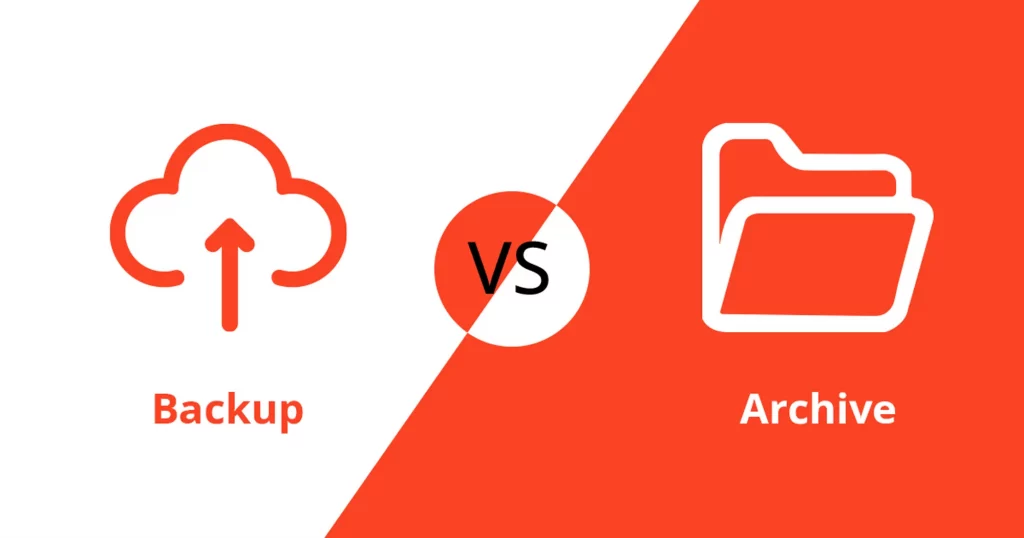Backup vs Archive – these two terms are often used interchangeably in the realms of data storage and retrieval, yet they hold different meanings and serve distinct purposes. Understanding the difference between backup and archive is crucial for businesses of all sizes, as each plays a unique role in a comprehensive data management strategy.
Backup and archive are two critical concepts that we will explain in this blog. We will delve into their individual strengths and uses. Additionally, we will explore how they complement each other in safeguarding your valuable data.
Backup
A backup is creating additional copies of important data and files for safekeeping. These copies or backups are stored in a separate location, local or cloud-based storage media. The primary objective of keeping backups is an extra layer of protection against data loss due to hardware failure, accidental deletion, cyberattacks, or other unforeseen events.
Archiving
Archiving, on the other hand, is the process of moving data that is no longer actively used to a separate storage location for long-term retention. The archived data is typically stored in a compressed and read-only format. Archiving frees up space on active storage systems while still allowing easy access to older data if needed. It also helps in maintaining compliance and regulatory requirements as per industry standards.
Backup vs Archive Main Differences
Backup vs archive, while seemingly similar in concept, are fundamentally different in their purpose and execution. The former focuses more on long-term retention, compliance, and space efficiency, while the latter primarily ensures data protection and recovery in the face of potential threats.
A comprehensive understanding of these concepts and their unique applications can lead to a more robust, efficient, and reliable data management strategy. Now, let’s delve deeper into the key differences between backup vs archive. The key differences between backup and archival data storage can be summarized as follows:
Purpose
While backups are primarily intended for short-term data retrieval in case of unexpected data loss, archiving serves the purpose of long-term data retention for future reference and to meet regulatory requirements.
Archiving allows organizations to preserve valuable data over extended periods, ensuring its availability for historical analysis and compliance purposes.

Data Accessibility
Backups are specifically designed for quick and efficient retrieval and restoration of data, providing immediate access in case of emergencies or system failures. On the other hand, archived data is not intended for frequent access and may require additional steps or processes to retrieve. This differentiation ensures that frequently accessed data is readily available while preserving less frequently accessed or historical data.
Storage Method
Backups generally create an exact copy of the data, resulting in larger storage requirements to accommodate the replicated information. In contrast, archiving often involves compressing data to save storage space, optimizing the utilization of storage resources. By compressing archived data, organizations can efficiently manage their storage infrastructure and minimize costs associated with long-term data retention.
Data Lifecycle Management
Archiving encompasses a more strategic approach to data lifecycle management. It considers the value of the data over time, its relevance to business operations, and the necessity for its long-term preservation.

Backups, on the other hand, typically follow a cyclic pattern where older backups are frequently overwritten with newer ones to ensure the availability of recent data in case of a restore. This cyclic nature prioritizes the most recent data for recovery purposes.
Storage Type (hot and cold)
Backup storage is designed to provide quick access, often referred to as “hot” storage. This type of storage usually consists of high-performance and costly storage media, making it suitable for frequent data retrieval and restoration purposes.
In contrast, archival data is typically stored in “cold” or long-term storage, involving lower-cost options such as tape drives or cloud-based cold storage services.
Regulatory Compliance
Archives are often designed with regulatory compliance in mind, providing an immutable and tamper-proof format for data preservation. This makes them suitable for audit trails, legal proceedings, and regulatory requirements. Archiving ensures that data is securely stored and maintained in a manner that meets legal and regulatory obligations, safeguarding the integrity and authenticity of the information for extended periods.
Archive vs Backup - Which one to choose?
Archive vs backup – the decision between these two relies heavily on an organization’s specific data management needs. Suppose the primary concern is data protection and quick recovery in the face of potential data loss due to unexpected events such as hardware failure or cyberattacks. In that case, backups are the best choice. They enable immediate data restoration and minimize downtime, which is crucial for business continuity. Backups are ideal for protecting current data that is frequently accessed and modified, making them a vital component of any disaster recovery strategy.

However, archiving is the way to go if the organization is more focused on long-term data retention for legal, regulatory, or historical purposes. Archiving is suited for preserving data that is no longer actively used but still holds value for the organization.
This data is stored efficiently in a compressed format, ensuring optimal utilization of storage resources and cost savings. Moreover, archiving provides a more strategic approach to data lifecycle management, considering the value and relevance of the data over time.
In conclusion, the main differences between backup vs archive lie in their purpose, data accessibility, storage method, data lifecycle management, regulatory compliance, and storage type. While backups provide quick data recovery for current and frequently accessed data, archiving ensures long-term retention of less actively used but valuable information.
Frequently Asked questions
What is the main purpose of a backup?
A backup primarily serves the purpose of short-term data retrieval in case of unexpected data loss. It is designed for quick and efficient retrieval and restoration of data.
What is data archiving?
Archiving is for long-term data retention for future reference and to meet regulatory requirements. It involves compressing data to save storage space and preserving valuable data over extended periods.
How does data lifecycle management differ in backups and archives?
Backups typically follow a cyclic pattern where older backups are overwritten with newer ones. Archiving takes a more strategic approach, considering the value and relevance of data over time.
Which storage type is used for backups and archives?
Backup storage, often called “hot” storage, consists of high-performance and costly storage media. Archival data is typically stored in “cold” or long-term storage, involving lower-cost options.
Should I choose backup or archive for my organization?
The choice depends on your organization’s specific needs. If immediate data restoration and disaster recovery are the primary concerns, backups are the best choice. If long-term data retention for legal, regulatory, or historical purposes is more important, go with archiving. They are complementary components of a comprehensive data management strategy.
